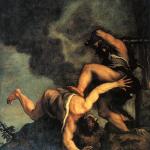
Does either the Bible or Catholicism require the serpent in Genesis to be taken absolutely literally?
Joslyn Renfrey’s words will be in blue.
*****
Well, on the science part, you do believe in Adam and Eve being the first two humans despite the impossibility of fitting the genetic diversity of our species into two people and additionally, that at least one snake at the time was able to speak, despite all snakes (both fossilized and modern) not having any indications of vocal chords or a cerebral cortex that contains a broca’s area.
There is no necessity to believe that 1) the Bible requires the serpent in Genesis to be taken absolutely literally, and/or 2) that Christians are required to take a literal interpretation of it.
International Standard Bible Encyclopedia (Protestant) states in its article, “Serpent”:
4. Figurative:
Most of the Biblical references to serpents are of a figurative nature, and they usually imply poisonous qualities. The wicked (Psalms 58:4), the persecutor (Psalms 140:3), and the enemy (Jeremiah 8:17) are likened to venomous serpents. The effects of wine are compared to the bites of serpents (Proverbs 23:32). Satan is a serpent (Genesis 3; Revelation 12:9; 20:2). The term “offspring of vipers” is applied by John the Baptist to the Pharisees and Sadducees (Matthew 3:7) or to the multitudes (Luke 3:7) who came to hear him; and by Jesus to the scribes and Pharisees (Matthew 12:34; 23:33).
Cardinal Ratzinger (later Pope Benedict XVI), in his book, ‘In the Beginning . . .’: A Catholic Understanding of the Story of Creation and the Fall (Huntington, Indiana: Our Sunday Visitor, 1990, from the 1986 German), wrote:
[T]he Bible is not a natural science textbook, nor does it intend to be such . . . One must distinguish between the form of portrayal and the content that is portrayed. The form would have been chosen from what was understandable at the time — from the images that surrounded the people who lived then . . . (pp.13-14)
Hence, when he writes later about the serpent and the fall of man (Genesis 3) — on pages 81-84, he uses words like “images” and “symbol.”
Like many biblical skeptics (I’ve debated scores of them), you probably have incorrect ideas of biblical interpretation and only a dim appreciation of biblical genre and the ancient Middle Eastern culture that produced it (things I have now studied in depth for 40 years).
You would not be alone. Many atheists of this sort that I have encountered, were raised in fundamentalism, and retain their rather simplistic, hyper-literalistic readings of the Bible, that invariably miss key and essential aspects of any given passage.
Christians aren’t required to believe in “talking snakes” any more than they must believe in a literal tree and fruit in the same passage. They are required to believe in the temptation and original sin / fall of man (i.e., rebellion against God) that the story poetically describes. But because you assume hyper-literalism, you can only imagine a process of looking in the fossils for a snake that had vocal cords.
I had been led to believe by many Catholics that they take the story entirely literally, as the original sin must exist in some form, for Jesus’s sacrifice to make sense.
Do you believe that the serpent was implying a ‘poisonous quality’, and if so, did this poisonous quality already exist in humanity before the fall (if we are also not taking Adam and Eve’s existence as literal either)?
As I said, we’re required to believe in original sin. How it is presented is not necessarily literal (i.e., literal original sin can be portrayed symbolically or poetically).
I didn’t deny that Adam and Eve were literal. They were. The fall was made possible by free will. God allowed the possibility of human beings rejecting Him. We thought we could make it on our own (just as atheists do), hence, the rebellion.
What do you think is referenced by the serpent, in this case? Is it some kind of poisonous (hostile) quality within humanity that was already present when they were created, or is it something else, like a feature of the environment that humanity found themselves in or some kind of agent?
I think it represents Satan (and angel / spirit), who had already rebelled against God, and was trying to bring down the human race with him. He probably recognized already how stupidly and idiotically he had acted, and so wanted to blame God. Misery loves company . . .
Would I be correct in thinking that you don’t think Satan’s presence is necessary for humanity’s free will?
Yes.
Well, you still wouldn’t deny Adam and Eve despite it being genetically impossible for humans to be descended from only two individuals- I’d still want to hear your thoughts on how you reconcile that, but lets continue:
Do you think that, without the serpent’s presence, that the fall would still have happened?
Probably (but not necessarily) so. Human beings were created with free will just as Satan was: to follow God’s will and His laws, or to reject both, and God Himself.
For a solid philosophical / scientific defense of monogenism (all human descent from one primal pair), see, “Science, Theology, and Monogenesis,” by Kenneth W. Kemp (American Catholic Philosophical Quarterly, Vol. 85, No. 2, pp. 217-236, 2011). See also, “Modern biology and original sin” (+ Part Two), by Dr. Ed Feser (another Catholic philosopher). Also, I have an in-depth article: Adam & Eve of Genesis: Historical & the Primal Human Pair?
***
(originally 6-1-17)
Photo credit: Eve and the Serpent (1909), by Joakim Skovgaard (1856-1933) [public domain / Wikimedia Commons / Creative Commons Attribution-Share Alike 3.0 Unported license]
***












